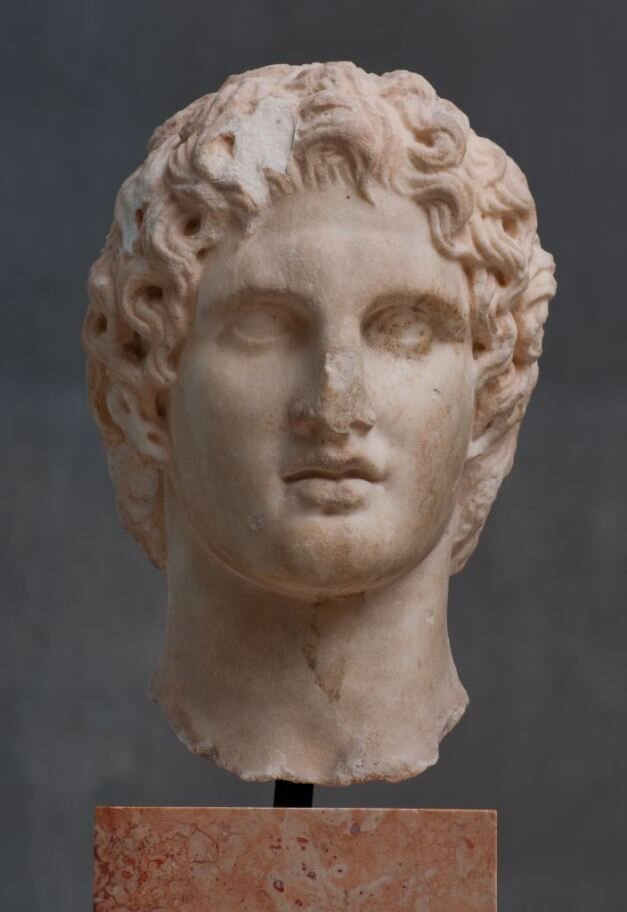Alexander the Great was an ancient Macedonian ruler and one of history’s greatest military minds who—as King of Greece and Persia—established the largest empire the ancient world had ever seen. By turns charismatic and ruthless, brilliant and power hungry, diplomatic and bloodthirsty, Alexander inspired such loyalty in his men they’d follow him anywhere and, if necessary, die in the process. Though Alexander the Great died before realizing his dream of uniting a new realm, his influence on Greek and Asian culture was so profound it inspired a new historical epoch—the Hellenistic Period.
Literary sources tell us, though perhaps not reliably, that Alexander (reigned 336-323 BC) chose only a few artists to produce his image, and famous names such as the sculptor Lysippos and the painter Apelles were associated with his portraiture. Though none of the famous images have been recovered, many sculptures in different materials, as well as portraits on gemstones and coins, survive. These were mostly produced long after Alexander’s death and while the portraits follow similar general characteristics, they also vary in style.
*Alexander's appearance has been most thought to be accurately depicted by the sculptor Lysippos, and in fact Alexander himself preferred Lysippos's likenesses of him over that of any other artist.
Marble Heads of Alexander The Great
Head of Alexander, found near the Erechtheion of the Athens Acropolis in 1886.
Thought to be an original work of the sculptor Leochares, made around 330 BC.
Acropolis Museum, Athens.
Marble head of Alexander From Pergamon,Turkey.
First half of 2nd century BC.
Istanbul Archaeological Museum.
Marble head of Alexander the Great, found in the Kerameikos,
Athens c. 300 BC.
Head of Alexander the Great, made of pentelic marble. It was found in the Kerameikos, Athens. Alexander wears the lion’s pelt, a common iconographic feature in depictions of the young king on coins, which hints at his descent from the mythical hero Herakles. The letters on Alexander’s face were carved at a later period.
Portrait of Alexander, Marble, Pella, 3rd century B.C.
Archaeological Museum of Pella
Alexander was always shown clean-shaven, which was an innovation: all previous portraits of Greek statesmen or rulers had beards. This royal fashion lasted for almost five hundred years and almost all of the Hellenistic kings and Roman emperors until Hadrian were portrayed beardless. Alexander was the first king to wear the all-important royal diadem, a band of cloth tied around the hair that was to become the symbol of Hellenistic kingship.
Earlier portraits of Alexander, in heroic style, look more mature than the portraits made after his death, such as this example. These show a more youthful, though perhaps more god-like character. He has longer hair, a more dynamic tilt of the head and an upward gaze, resembling his description in literary sources.
This head was acquired in Alexandria, the city founded by Alexander in 331 BC, and the location of his tomb. Alexandria was also the capital of the longest surviving Hellenistic dynasty, the Ptolemies. From the time of the reign of Ptolemy I Soter (‘Saviour’) (305-282 BC), Alexander was worshipped as a god and the forefather of the dynasty.
Youthful image of the conqueror king
Hellenistic Greek, 2nd-1st century BC, Said to be from Alexandria, Egypt.
The Face of Alexander the Great (Photoshop Reconstruction)
There are a few copies of Lysippus’ sculptures, including the one below, which shows a pretty standard Mediterranean visage.
A Roman copy of a bronze made by Lysippus
Roman, Imperial (1st-2nd century AD)
Location: Sully wing, Ground floor, Athena gallery (also called the Melpomene gallery), Room 344
Modern Latin inscription: “This effigy of Alexander the Great, discovered in 1779 (in the Piso villa) at Tivoli, was restored by Joseph Nicolas Azara.”
*Alexander's physical description is variously reported as of him having curly, dark blonde hair, a prominent forehead, a short, jutting chin, fair to reddish skin, an intense gaze, and a short, stocky, tough figure. It has been commented upon more than once that Alexander had one dark brown eye and one blue eye! Such a phenomenon does exist, so it is not too much to suppose that Alexander could also have exhibited this trait.
Video: The Face of Alexander the Great (Photoshop Reconstruction)
But these statues are not our only image sources. The Alexander Mosaic, a recovered floor decoration, depicts Alexander with distinctly Middle Eastern features, although as a Roman-era image it should be taken with a grain of salt.
The Alexander Mosaic, dating from circa 100 BC, is a Roman floor mosaic originally from the House of the Faun in Pompeii, that is allegedly an imitation of Apelles' painting. It depicts a battle between the armies of Alexander the Great and Darius III of Persia and measures 2.72 by 5.13 metres (8 ft 11 in × 16 ft 10 in). The original is preserved in the Naples National Archaeological Museum. The mosaic is believed to be a copy of an early 3rd-century BC Hellenistic painting.
Ultimately, however, most people would have seen Alexander as the stylised depictions on his silver coins. Or rather, what they assumed was Alexander. In fact, the face on the obverse is that of Heracles, and erroneously assumed by the creator of the Alexander Sarcophagus at Sidon to depict Alexander himself. Note the lion pelt headgear, a standard Herculean feature, and the lack of a ram’s horn, a symbol of Zeus Ammon appropriated by Alexander on imagery to suggest his own divinity.
In fact, it is post-Alexandrian coinage that actually depicts him, such as this example by Lysimachus.
So, we don’t know for absolute certain. All primary images are gone, so we must rely on what we do have. His facial structure is likely a mixture of those depicted on his statues, Successor-era coins and the Alexander Mosaic, probably closer to the former two than the latter one. Being of mainly Greek heritage, Alexander was almost certainly of Mediterranean complexion and hair colour.
When we explore the glorious life of Alexander the Great, we can't help but be shocked by his legendary deeds and far-reaching influence. The image of this great conqueror of Greek descent transcends time and space and still inspires countless people today.
If you are a military fan and a personal fan of Alexander the Great, you might as well customize some custom coins that are similar to cultural relics. The front of the customized coin can be printed with the head of Alexander the Great, and the back can be printed with your name or a favorite quote. This can not only perfectly show the heroic image of Alexander the Great, but also express the heroic dream deep in your heart.
Where Was Alexander the Great From?
Alexander III was born in Pella, Macedonia (a region on the northern part of the Greek peninsula) , in 356 B.C. to King Philip II and Queen Olympias—although legend had it his father was none other than Zeus, the ruler of the Greek gods.
Philip II was an impressive military man in his own right. He turned Macedonia into a force to be reckoned with, and he fantasized about conquering the massive Persian Empire.
What was Alexander the Great's ethnicity?
Alexander was the son of the King of Macedonia (a Greek kingdom) and a Princess from Epiros (another Greek kingdom). He spoke Greek, worshiped the Greek gods and spread Greek culture throughout the Eastern Mediterranean. He made Greek the dominant language and culture of what became known as the Hellenistic period. He was ethnically Greek.
How did Alexander the Great die and when? Death of Alexander the Great
The death of Alexander the Great and subsequent related events have been the subjects of debates. According to a Babylonian astronomical diary, Alexander died between the evening of June 10 and the evening of June 11, 323 BC, at the age of thirty-two. This happened in the palace of Nebuchadnezzar II in Babylon.Macedonians and local residents wept at the news of the death, while Achaemenid subjects shaved their heads. The mother of Darius III, Sisygambis, having learned of Alexander's death, refused sustenance and died a few days later. Historians vary in their assessments of primary sources about Alexander's death, which results in different views.
Proposed causes of Alexander's death included alcoholic liver disease, fever, and strychnine poisoning, but little data support those versions. According to the University of Maryland School of Medicine report of 1998, Alexander probably died of typhoid fever (which, along with malaria, was common in ancient Babylon). In the week before Alexander's death, historical accounts mention chills, sweats, exhaustion and high fever, typical symptoms of infectious diseases, including typhoid fever. According to David W. Oldach from the University of Maryland Medical Center, Alexander also had "severe abdominal pain, causing him to cry out in agony. The associated account, however, comes from the unreliable Alexander romance. According to Andrew N. Williams and Robert Arnott, in Alexander the Great's last days he became mute. He became mute because of a previous injury to his neck from the Siege of Cyropolis.



















